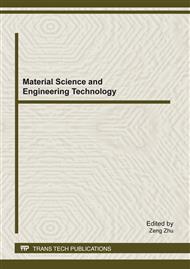[1]
R. J. Wai, W. H. Wang and C. Y. Lin: High-performance stand-alone photovoltaic generation in system, IEEE Trans. Ind. Electron. vol. 55 (2008) p.240–250.
DOI: 10.1109/tie.2007.896049
Google Scholar
[2]
C. Wang and M. H. Nehrir: Power management of a standalone wind/photovoltaic/fuel cell energy system, IEEE Trans. Energy Convers. vol. 23 (2008), p.957–967.
DOI: 10.1109/tec.2007.914200
Google Scholar
[3]
Y. Gu, Z. Lu, Z. Qian, X. Gu and L. Hang: A novel ZVS resonant reset dual switch forward DC–DC converter, IEEE Trans. Power Electron. vol. 22 (2007), p.96–103.
DOI: 10.1109/tpel.2006.886612
Google Scholar
[4]
C. H. Chan and M. H. Pong: Input current analysis of interleaved boost converters operating in discontinuous-inductor current mode, IEEE Power Electron. Soc. Conf., (1997).
DOI: 10.1109/pesc.1997.616754
Google Scholar
[5]
C. M. Stein, J. R. Pinheiro and H. L. Hey: A ZCT auxiliary commutation circuit for interleaved boost converters operating in critical conduction mode, IEEE Trans. Power Electron. vol. 17 (2002), p.954–962.
DOI: 10.1109/tpel.2002.805607
Google Scholar
[6]
P. W. Lee, Y. S. Lee, D. K. Cheng and X. C. Liu: Steady-state analysis of an interleaved boost converter with coupled inductors, IEEE Trans. Ind. Electron. vol. 47 (2000), p.787–795.
DOI: 10.1109/41.857959
Google Scholar
[7]
S. Park, So. Park, J. Yu, Y. Jung, and C. Won: Analysis and Design of a Soft Switching Boost Converter With an HI-Bridge Auxiliary Resonant Circuit, IEEE Trans. Power Electron. vol. 25 (2010), p.2142–2149.
DOI: 10.1109/tpel.2010.2046425
Google Scholar
[8]
Y. Hsieh, T. Hsueh and H. Yen: An interleaved boost converter with zero-voltage transition, IEEE Trans. Power Electron. vol. 24 (2009), p.973–978.
DOI: 10.1109/tpel.2008.2010397
Google Scholar
[9]
Hyun-Lark Do: A Soft-Switching DC/DC Converter With High Voltage Gain, IEEE Trans. Power Electron. vol. 25 (2010), p.1193–1200.
DOI: 10.1109/tpel.2009.2039879
Google Scholar
[10]
S. Park and S. Choi: Soft-Switched CCM Boost Converters With High Voltage Gain for High-Power Applications, IEEE Trans. Power Electron. vol. 25 (2010), p.1211–1217.
DOI: 10.1109/tpel.2010.2040090
Google Scholar
[11]
W. Li and X. He: An Interleaved Winding-Coupled Boost Converter With Passive Lossless Clamp Circuits, IEEE Trans. power Electron. vol. 22 (2007), p.1499–1507.
DOI: 10.1109/tpel.2007.900521
Google Scholar


